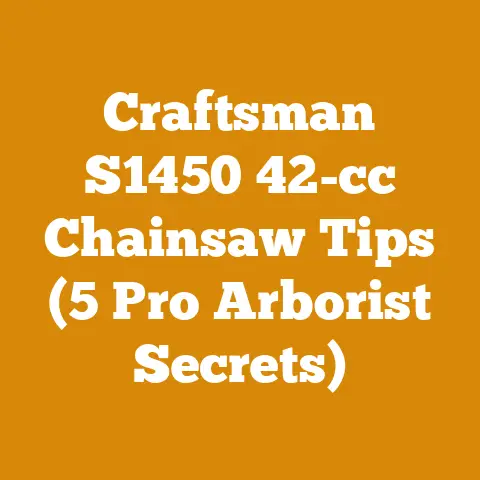Stihl Chainsaw Clutch Replacement (029 Model) – Expert Tips Inside
Replacing the clutch on a Stihl 029 chainsaw might seem daunting, but with the right guidance, it’s a task any reasonably handy person can tackle. I’ve rebuilt countless chainsaws over the years, and the Stihl 029 is a model I know intimately. Its robust design makes it a reliable workhorse, but like any machine, parts wear down. The clutch is a critical component, transferring power from the engine to the chain. When it fails, your saw won’t cut properly, and you risk damaging other parts. This guide is designed to walk you through the entire clutch replacement process, offering expert tips and insights I’ve gained from years of experience.
Stihl Chainsaw Clutch Replacement (029 Model) – Expert Tips Inside
Understanding the Stihl 029 Clutch System
Before diving into the replacement, let’s understand the clutch system in your Stihl 029. The clutch is a centrifugal type, meaning it engages based on engine speed. As the engine revs up, centrifugal force causes the clutch shoes to expand outward and grip the clutch drum, which is connected to the chain sprocket. When the engine idles, the springs retract the shoes, disengaging the chain.
- Components: The clutch assembly typically consists of the clutch shoes, clutch springs, clutch drum (which often includes the sprocket), and the clutch retaining nut.
- Symptoms of a Failing Clutch: Common signs include chain slippage (especially under load), difficulty starting the saw, excessive heat from the clutch area, and a rattling noise at idle.
- Why Replace It? A worn clutch can lead to reduced cutting performance, increased fuel consumption, and potential damage to the engine or chain. Ignoring a failing clutch is like driving a car with worn brakes – eventually, it will lead to a more significant (and expensive) problem.
Gathering Your Tools and Materials
Having the right tools is half the battle. Here’s what I recommend you have on hand:
- New Clutch Assembly: Purchase a high-quality replacement clutch assembly specifically designed for the Stihl 029. I prefer OEM Stihl parts for reliability, but aftermarket options can work well too. Just be sure to read reviews and choose a reputable brand.
- Piston Stop Tool: This tool is essential for preventing the piston from moving while you loosen the clutch nut. Trust me, trying to do this without a piston stop is a recipe for frustration (and potential engine damage).
- Clutch Removal Tool: A specialized clutch removal tool (often a combination wrench and screwdriver-like tool) makes the process much easier. While you can sometimes use a screwdriver and hammer, the proper tool minimizes the risk of damaging the clutch or surrounding components.
- Socket Wrench and Sockets: You’ll need a socket wrench and a selection of sockets to remove the chain brake assembly and any other necessary parts.
- Screwdrivers (Flathead and Phillips): Various screwdrivers will be needed for removing covers and other small components.
- Gloves: Protect your hands from dirt, grease, and sharp edges.
- Shop Rags: Keep plenty of shop rags handy for cleaning and wiping up spills.
- Penetrating Oil: A good penetrating oil like WD-40 or PB Blaster can help loosen stubborn nuts and bolts.
- Grease: A small amount of high-temperature grease for lubricating the clutch drum bearing.
- Torque Wrench: For properly tightening the clutch nut during reassembly.
- Parts Tray: A tray to keep all the small parts organized and prevent them from getting lost.
Personal Story: I once tried to replace a clutch without a piston stop tool. Let’s just say it involved a lot of swearing, a jammed piston, and a trip to the repair shop. Learn from my mistake – invest in the right tools!
Safety First: Preparing Your Work Area and the Chainsaw
Safety is paramount when working with any power equipment. Before you even think about touching the chainsaw, take these precautions:
- Disconnect the Spark Plug: This is the most crucial step. Remove the spark plug wire to prevent accidental starting.
- Allow the Engine to Cool: Never work on a hot engine. Let it cool down completely before starting the repair.
- Wear Safety Glasses: Protect your eyes from flying debris.
- Wear Gloves: Protect your hands from sharp edges and contaminants.
- Work in a Well-Ventilated Area: Chainsaws can emit fumes, so work in a well-ventilated space.
- Clear Your Work Area: Ensure you have plenty of space to work and that there are no trip hazards.
- Refer to the Owner’s Manual: Your Stihl 029 owner’s manual contains valuable information about your specific model. Consult it for detailed diagrams and instructions.
Step-by-Step Clutch Replacement Procedure
Now, let’s get to the heart of the matter – replacing the clutch. I’ll break down each step in detail, providing tips and insights along the way.
Step 1: Removing the Chain and Bar
This is a straightforward step, but it’s worth mentioning for completeness.
- Loosen the bar nuts that secure the chain bar cover.
- Remove the chain bar cover.
- Carefully remove the chain from the bar.
- Remove the bar from the chainsaw.
Tip: Before removing the chain, take a moment to inspect it for wear and tear. If it’s damaged or worn, consider replacing it along with the clutch.
Step 2: Removing the Chain Brake Assembly
The chain brake assembly needs to be removed to access the clutch.
- Locate the chain brake handle.
- Typically, there are screws or clips holding the chain brake assembly in place. Remove these carefully.
- Gently detach the chain brake assembly. You might need to wiggle it slightly to free it.
Important Note: Pay attention to how the chain brake assembly is installed. You’ll need to reassemble it correctly later. Taking photos or making notes can be helpful.
Step 3: Securing the Piston with the Piston Stop Tool
This is where the piston stop tool comes in.
- Remove the spark plug.
- Insert the piston stop tool into the spark plug hole. Gently rotate the flywheel until the piston stop tool engages the piston, preventing it from moving.
Caution: Don’t force the piston stop tool. If it doesn’t engage easily, rotate the flywheel slightly in the opposite direction and try again. Forcing it can damage the piston.
Step 4: Loosening and Removing the Clutch Nut
The clutch nut is typically reverse-threaded, meaning you’ll need to turn it clockwise to loosen it.
- Position the clutch removal tool on the clutch nut.
- Using a wrench, turn the clutch nut clockwise to loosen it. It might be quite tight, so apply steady pressure.
- Once the nut is loose, remove it completely.
Expert Tip: If the clutch nut is extremely stubborn, try applying some penetrating oil and letting it soak for a few minutes. You can also use a heat gun to gently warm the nut, which can help loosen it.
Step 5: Removing the Old Clutch Assembly
With the nut removed, you can now remove the old clutch assembly.
- Carefully pull the clutch assembly straight off the crankshaft.
- Inspect the crankshaft for any signs of damage or wear.
Note: The clutch assembly might be a bit stuck. Gently wiggle it back and forth while pulling to help loosen it. Avoid using excessive force, as you don’t want to damage the crankshaft.
Step 6: Cleaning and Inspecting the Clutch Area
Before installing the new clutch, take some time to clean and inspect the area.
- Use a shop rag to clean the crankshaft and surrounding area.
- Inspect the crankshaft for any signs of damage, such as scoring or wear.
- Check the clutch drum bearing for smooth rotation. If it feels rough or gritty, replace it.
Why This Matters: A clean and properly lubricated clutch area will ensure smooth operation and prolong the life of the new clutch.
Step 7: Installing the New Clutch Assembly
Now for the fun part – installing the new clutch!
- Apply a small amount of high-temperature grease to the clutch drum bearing.
- Carefully slide the new clutch assembly onto the crankshaft.
- Make sure the clutch assembly is fully seated on the crankshaft.
Tip: Ensure the clutch shoes are oriented correctly. They should be facing outward, ready to engage with the clutch drum.
Step 8: Reinstalling the Clutch Nut
- Thread the clutch nut onto the crankshaft. Remember, it’s reverse-threaded.
- Use the clutch removal tool and a torque wrench to tighten the clutch nut to the manufacturer’s specified torque. Consult your Stihl 029 service manual for the correct torque specification. Typically, it’s around 40-50 Nm (30-37 ft-lbs).
Critical Step: Properly torquing the clutch nut is essential. Over-tightening can damage the clutch or crankshaft, while under-tightening can cause the clutch to loosen and fail.
Step 9: Removing the Piston Stop Tool and Reinstalling the Spark Plug
- Remove the piston stop tool from the spark plug hole.
- Reinstall the spark plug and tighten it to the manufacturer’s specified torque.
Important: Make sure you remove the piston stop tool before attempting to start the engine. Starting the engine with the tool in place can cause serious damage.
Step 10: Reinstalling the Chain Brake Assembly
- Carefully reattach the chain brake assembly, ensuring it’s properly aligned.
- Secure the chain brake assembly with the screws or clips you removed earlier.
Double-Check: Test the chain brake to ensure it’s functioning correctly. The chain should stop immediately when the brake is engaged.
Step 11: Reinstalling the Chain and Bar
- Reinstall the chain onto the bar.
- Position the bar on the chainsaw.
- Reinstall the chain bar cover and tighten the bar nuts.
Final Check: Make sure the chain is properly tensioned. It should have a slight amount of slack but not be too loose.
Testing Your Work
Before you head out to cut wood, it’s crucial to test your work.
- Start the Chainsaw: Start the chainsaw and let it idle. The chain should not be moving at idle.
- Engage the Throttle: Gradually increase the throttle. The chain should engage smoothly and without slippage.
- Test the Chain Brake: Engage the chain brake. The chain should stop immediately.
- Listen for Unusual Noises: Listen for any unusual noises, such as rattling or grinding. If you hear anything suspicious, shut off the saw and investigate.
Troubleshooting:
- Chain Slippage: If the chain slips, the clutch nut might be loose, or the clutch shoes might be worn.
- Chain Moving at Idle: If the chain moves at idle, the clutch springs might be weak or broken.
- Excessive Heat: If the clutch area becomes excessively hot, the clutch might be slipping or improperly lubricated.
Maintenance Tips to Extend Clutch Life
Replacing the clutch is a good opportunity to implement some maintenance practices that will extend the life of your new clutch and your chainsaw in general.
- Proper Chain Tension: Maintain proper chain tension. A loose chain puts extra stress on the clutch.
- Sharp Chain: Keep your chain sharp. A dull chain requires more power to cut, which can overload the clutch.
- Proper Lubrication: Use high-quality bar and chain oil to keep the chain and bar properly lubricated.
- Avoid Overloading: Don’t force the saw through wood. Let the chain do the work. Overloading the saw can damage the clutch and engine.
- Regular Cleaning: Keep the clutch area clean and free of debris.
- Inspect Regularly: Inspect the clutch assembly regularly for signs of wear or damage.
Personal Anecdote: I once had a customer who kept burning through clutches on his Stihl 029. After some investigation, I discovered he was using the wrong type of bar and chain oil. Switching to a high-quality oil made a huge difference in clutch life.
Understanding Clutch Wear and Failure
Knowing the common causes of clutch wear and failure can help you prevent future problems.
- Normal Wear and Tear: Over time, the clutch shoes and springs will naturally wear down due to friction and heat.
- Overloading: Forcing the saw through wood or using a dull chain can overload the clutch, causing it to wear out prematurely.
- Improper Lubrication: Lack of lubrication can cause the clutch to overheat and fail.
- Contamination: Dirt, sawdust, and other debris can contaminate the clutch, causing it to slip and wear out.
- Weak or Broken Springs: Weak or broken clutch springs can prevent the clutch from disengaging properly, causing the chain to move at idle or slip under load.
Choosing the Right Replacement Clutch
When selecting a replacement clutch, you have two main options: OEM (Original Equipment Manufacturer) and aftermarket.
- OEM Clutches: OEM clutches are manufactured by Stihl and are designed to meet the exact specifications of your chainsaw. They are typically more expensive than aftermarket clutches but offer superior quality and reliability.
- Aftermarket Clutches: Aftermarket clutches are manufactured by third-party companies. They can be a more affordable option, but the quality can vary significantly. When choosing an aftermarket clutch, be sure to read reviews and select a reputable brand.
My Recommendation: For critical components like the clutch, I generally recommend using OEM parts whenever possible. The higher cost is usually worth it in terms of performance and longevity. However, if you’re on a tight budget, a well-reviewed aftermarket clutch can be a viable option.
Advanced Troubleshooting: Beyond the Clutch
Sometimes, clutch-like symptoms can be caused by other issues. Here are a few things to consider:
- Worn Sprocket: A worn sprocket can cause the chain to slip, even if the clutch is in good condition. Inspect the sprocket for wear and replace it if necessary.
- Damaged Chain: A damaged or worn chain can also cause slippage. Inspect the chain for damage and replace it if necessary.
- Carburetor Issues: A poorly adjusted carburetor can cause the engine to run erratically, which can affect clutch performance.
- Ignition Problems: Ignition problems can also cause the engine to run poorly, leading to clutch slippage.
Clutch Maintenance Schedule
To keep your chainsaw running smoothly and prevent clutch problems, I recommend following this maintenance schedule:
- After Each Use: Clean the clutch area and inspect for any signs of damage.
- Monthly: Lubricate the clutch drum bearing.
- Annually: Inspect the clutch shoes and springs for wear and replace them if necessary.
The Importance of Professional Service
While this guide provides detailed instructions for replacing your Stihl 029 clutch, there are times when it’s best to seek professional help.
- If You’re Not Comfortable Working on Chainsaws: If you’re not mechanically inclined or comfortable working on power equipment, it’s best to leave the repair to a qualified technician.
- If You Encounter Difficulties: If you encounter difficulties during the repair process, don’t force anything. Seek professional help to avoid damaging your chainsaw.
- For Complex Repairs: If the problem is more complex than a simple clutch replacement, it’s best to take your chainsaw to a professional.
Final Thoughts
Replacing the clutch on a Stihl 029 chainsaw is a manageable task with the right tools, knowledge, and a bit of patience. By following this guide and taking proper precautions, you can save money and keep your chainsaw running smoothly for years to come. Remember, safety is always the top priority. If you’re ever unsure about a step, don’t hesitate to seek professional help. Now, get out there and get cutting!






